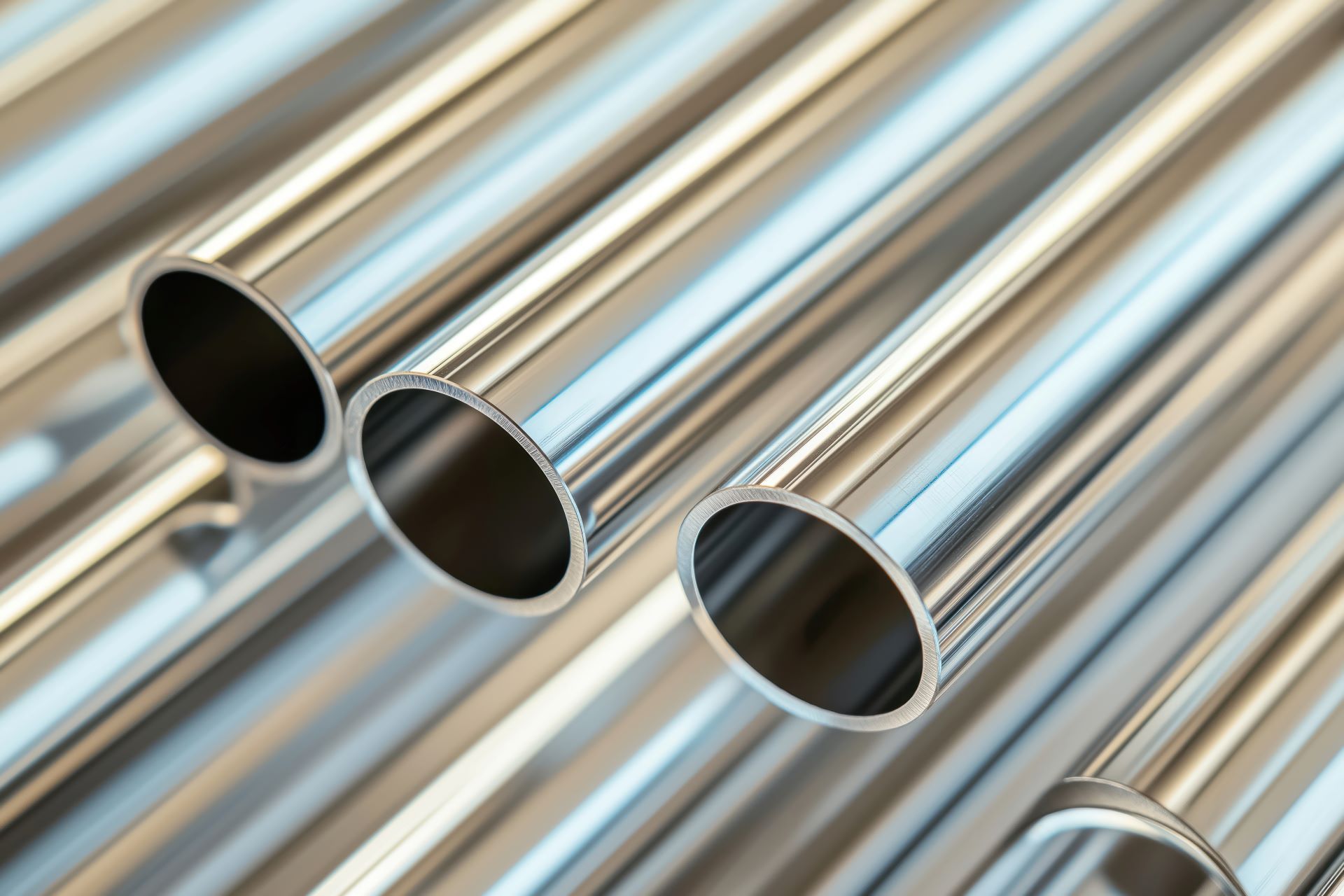Understanding Stainless Steel Flanges: Types, Applications, and How to Choose the Right One
In industrial piping systems, stainless steel flanges are critical connection points providing reliable joining, sealing, and alignment for pipes, valves, pumps, and equipment. Flanges simplify assembly, allow for system disassembly or inspection, and support pressure containment across a wide range of process environments.
For engineers, buyers, and fabricators, selecting the right flange isn’t just about matching size. The flange type, facing, material grade, pressure class, and connection method all influence long-term performance, especially in corrosive, high-pressure, or high-temperature systems.
At Action Stainless, we support industrial and sanitary piping applications by supplying stainless steel flanges in multiple configurations cut to spec, certified, and ready for immediate use. Our in-stock inventory covers ANSI, ASME, and industry-standard flange types in the most in-demand grades, with
value-added cutting and in-house service that keeps projects moving.
What Is a Stainless Steel Flange?
A stainless steel flange is a mechanical component used to connect piping or equipment together in a sealed, bolted system. Flanges are typically round, flat-faced, and machined with bolt holes and a sealing face. They are welded or threaded onto pipe ends and joined with gaskets and bolts to form a leak-proof connection.
The strength and corrosion resistance of stainless steel make it ideal for flanges used in:
- Food and beverage processing
- Chemical manufacturing
- Oil and gas
- Marine and offshore
- Water treatment
- Pharmaceutical and biotech
- Power generation
Unlike carbon steel flanges, stainless options resist rust, corrosion, and bacterial growth, making them suitable for sanitary, corrosive, or outdoor environments.
Common Stainless Steel Flange Types
Each flange design serves a different mechanical function depending on the piping system’s layout, pressure, and maintenance requirements. Below is an overview of the most widely used flange types in stainless steel piping:
| Flange Type | Description | Common Uses |
|---|---|---|
| Weld Neck (WN) | Long tapered hub, butt-welded to pipe | High-pressure, high-temperature systems |
| Slip-On (SO) | Slides over pipe, fillet welded inside and out | Low-pressure piping, easy installation |
| Socket Weld (SW) | Recessed hub, fillet welded on one side | Small-diameter piping in high-pressure systems |
| Threaded (TH) | Screwed-on connection, no welding | Maintenance-friendly, flammable areas |
| Lap Joint (LJ) | Used with stub end, allows flange rotation | Systems requiring frequent disassembly |
| Blind (BL) | Solid disk with no bore | Closing pipe ends or vessel nozzles |
| Orifice Flanges | Paired flanges with pressure taps | Flow metering in process control systems |
Each flange type is machined to accommodate specific pipe schedules and bolt circles, with different
facing styles (raised face, flat face, ring type joint) to suit gasket and sealing needs.
Why Stainless Steel Is the Preferred Flange Material
In corrosive, sanitary, or mission-critical systems, stainless steel provides a combination of performance traits that few materials can match:
- Excellent corrosion resistance across a wide pH range
- Strength and toughness under pressure or temperature
- Compatibility with sanitary environments, including FDA and 3-A compliant applications
- No need for coatings or painting, reducing long-term maintenance
- Temperature stability, especially with high-performance grades like 316 or 321
Whether you’re dealing with brine, steam, acids, or cleaning chemicals, stainless steel flanges offer predictable durability and performance. At Action Stainless, we stock flanges in
304, 316, 316L, and specialty alloys to align with system demands.
Facing Types and Pressure Classes
The flange face determines how it seals to the mating flange and what gasket is compatible. The most common flange facing types include:
- Raised Face (RF): Slightly elevated sealing surface; used in most industrial systems
- Flat Face (FF): Entire surface is flat; used in low-pressure and ductile iron systems
- Ring Type Joint (RTJ): Precision-machined groove for metal ring gasket; used in high-pressure, critical services
Each flange is also rated by a pressure class, typically following ANSI/ASME B16.5 standards:
| Class | Typical Pressure Rating |
|---|---|
| 150 | Low pressure (up to 285 psi at 100°F) |
| 300 | Medium pressure (up to 740 psi at 100°F) |
| 600 | High pressure (up to 1,480 psi at 100°F) |
| 900/1500/2500 | Extreme pressure systems |
Selecting the proper pressure class and facing type ensures gasket compatibility, leak protection, and structural safety under system loads.
Applications Across Industries
Stainless steel flanges are used anywhere that pipe systems require secure, reliable, and serviceable joints. Some examples include:
Food & Beverage
Used with sanitary tubing and CIP (clean-in-place) systems. Requires smooth bore transitions and often uses 316L stainless with polished finishes.
Chemical Processing
Corrosion-resistant flanges are essential for acidic or caustic chemicals, especially in bulk storage and transfer lines.
Marine & Offshore
Saltwater environments demand 316 or duplex stainless flanges that resist pitting and crevice corrosion, especially for pumps, manifolds, and deck piping.
Water Treatment
Chlorine, fluoride, and other treatment chemicals can attack standard metals. Stainless flanges maintain durability and performance in municipal and industrial treatment systems.
Pharmaceutical & Biotech
Sanitary flanges with electropolished or polished finishes reduce biofilm risk. Stainless is used in sterile filtration, fermentation tanks, and process piping.
Energy & Power Generation
Steam and condensate systems use high-pressure stainless flanges, especially in biomass, geothermal, and nuclear applications.
Choosing the Right Stainless Flange
To make the correct selection, engineers must evaluate several key factors beyond just pipe diameter. These include:
- Flange Type: Based on connection method, maintenance needs, and alignment
- Pipe Schedule: To match wall thickness and ID of the mating pipe
- Material Grade: 304 for general use; 316 for aggressive or sanitary environments
- Facing Type: To suit gasket material and pressure containment
- Pressure Class: Based on process pressure and temperature
- Standards Compliance: ANSI, ASME, or DIN standards as required by the system
Working with an experienced supplier like Action Stainless can streamline the decision-making process. Our team can help identify compatible materials, facing types, and pressure classes based on the pipe system design and service conditions.
In-House Inventory and Processing Capabilities
At Action Stainless, we supply a full range of stainless steel flanges in standard and specialty configurations. We offer:
- 304, 304L, 316, 316L stainless flanges
- Raised face, flat face, and RTJ configurations
- ANSI/ASME B16.5 flanges from Class 150 to Class 600
- Weld neck, slip-on, socket weld, blind, and threaded styles
- In-stock availability for fast lead times
We also support your operations with in-house value-added services:
- Saw cutting and prep for custom flange lengths or connections
- Shearing and drilling for bolt pattern compatibility
- Packaging and delivery with MTR documentation and traceability
- Expert consultation on grade selection and facing compatibility
Our team is committed to helping engineers and fabricators reduce project delays and ensure flange compatibility across complex piping systems.
Documentation and Compliance
Industrial piping systems often require full traceability, especially for high-pressure, food-grade, or regulated applications. Action Stainless provides:
- Mill Test Reports (MTRs) for stainless flanges
- Documentation supporting ASME, ASTM, and ANSI standards
- Lot traceability for QA and compliance audits
- Support for regulated industries, including food, pharma, and energy
When certification and verification matter, our internal systems ensure full accountability across every flange, every order.
Final Thoughts: Why Flange Selection Matters
Flanges may seem like a small part of a larger piping system, but their reliability directly impacts safety, longevity, and ease of maintenance. The wrong flange type or material can lead to leaks, stress failures, or downtime. Choosing the correct stainless steel flange based on application, pressure, and material compatibility is critical to achieving long-term performance.
By working with Action Stainless, fabricators and system designers gain access to:
- Certified stainless steel flanges in-stock
- Expert selection support
- In-house cutting, processing, and logistics
- Reliable turnaround and documentation
Whether you're building sanitary piping for a food facility or chemical lines for industrial processing, we supply flanges that match the spec and deliver lasting performance.






